What is Graphene Oxide?
Graphene is a material made of carbon atoms that are bonded together in a repeating pattern of hexagons. Graphene is so thin that it is considered two dimensional. Graphene is considered to be the strongest material in the world, as well as one of the most conductive to electricity and heat. Graphene has endless potential applications, in almost every industry (like electronics, medicine, aviation and much more).
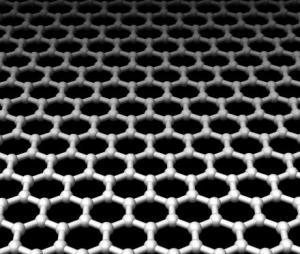
As graphene is expensive and relatively hard to produce, great efforts are made to find effective yet inexpensive ways to make and use graphene derivatives or related materials. Graphene oxide (GO) is one of those materials - it is a single-atomic layered material, made by the powerful oxidation of graphite, which is cheap and abundant. Graphene oxide is an oxidized form of graphene, laced with oxygen-containing groups. It is considered easy to process since it is dispersible in water (and other solvents), and it can even be used to make graphene. Graphene oxide is not a good conductor, but processes exist to augment its properties. It is commonly sold in powder form, dispersed, or as a coating on substrates.
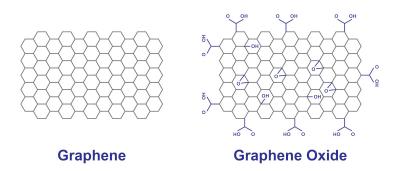
Graphene oxide is synthesized using four basic methods: Staudenmaier, Hofmann, Brodie and Hummers. Many variations of these methods exist, with improvements constantly being explored to achieve better results and cheaper processes. The effectiveness of an oxidation process is often evaluated by the carbon/oxygen ratios of the graphene oxide.
Graphene oxide uses
Graphene Oxide films can be deposited on essentially any substrate, and later converted into a conductor. This is why GO is especially fit for use in the production of transparent conductive films, like the ones used for flexible electronics, solar cells, chemical sensors and more. GO is even studied as a tin-oxide (ITO) replacement in batteries and touch screens.
Graphene Oxide has a high surface area, and so it can be fit for use as electrode material for batteries, capacitors and solar cells. Graphene Oxide is cheaper and easier to manufacture than graphene, and so may enter mass production and use sooner.
GO can easily be mixed with different polymers and other materials, and enhance properties of composite materials like tensile strength, elasticity, conductivity and more. In solid form, Graphene Oxide flakes attach one to another to form thin and stable flat structures that can be folded, wrinkled, and stretched. Such Graphene Oxide structures can be used for applications like hydrogen storage, ion conductors and nanofiltration membranes.
Graphene oxide is fluorescent, which makes it especially appropriate for various medical applications. bio-sensing and disease detection, drug-carriers and antibacterial materials are just some of the possibilities GO holds for the biomedical field.
Buy Graphene Oxide
Graphene oxide is relatively affordable and easy to find, with many companies that sell it. It does, however, get confusing since different companies offer products that vary in quality, price, form and more - making the choice of a specific product challenging. If you are interested in buying GO, contact Graphene-Info for advisement on the right GO for your exact needs!
Further reading
The latest graphene oxide news:
Researchers 3D print graphene-oxide soft robots
Researchers from China’s Harbin Institute of Technology have 3D printed a soft robot from graphene-oxide that is capable of moving backward and forwards when exposed to moisture.
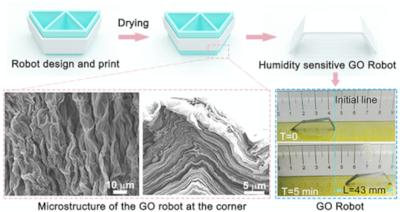
The scientists combined Direct Ink Writing (DIW) 3D printing and constrained drying techniques to fabricate the soft robot, and were able to overcome the porosity, shrinkage and structure uniformity challenges previously observed when 3D printing graphene-oxide objects.
Graphene-Info updates all its graphene market report
Today we published new versions of all our graphene market reports. Graphene-Info provides comprehensive niche graphene market reports, and our reports cover everything you need to know about these niche markets. The reports are now updated to January 2022.
The Graphene Batteries Market Report:
- The advantages using graphene batteries
- The different ways graphene can be used in batteries
- Various types of graphene materials
- What's on the market today
- Detailed specifications of some graphene-enhanced anode material
- Personal contact details into most graphene developers
The report package provides a good introduction to the graphene battery - present and future. It includes a list of all graphene companies involved with batteries and gives detailed specifications of some graphene-enhanced anode materials and contact details into most graphene developers. Read more here!
G6 Materials announces testing agreement of GO materials with U.S. Army
G6 Materials has announced that its wholly owned subsidiary, Graphene Laboratories (GLI), has entered into a Testing Services Agreement (the TSA) with the U.S. Army Engineer Research & Development Center (U.S. Army ERDC) in Vicksburg, Mississippi.
GLI will be assessing the performance characteristics and quality of graphene oxide (GO) materials in order to help solve environmental challenges. Development of GO materials with superior adsorptive capabilities for the removal of complex contaminants will take place, with 10 specific tests to be conducted by the U.S. Army ERDC on GLI’s GO materials. The project will run for an expected time frame of one year.
Tata Steel develops a unique few-layer rGO film material
Tata Steel has developed a new product, a few-layer film of rGO along with its collaborators at CeNS, Bengaluru. The company is now starting to mass-produce the films and offer them to application developers.
Figure 1: (a) Digital image of rGO/Cu foil (5 cm2). Contactact angle (b) and AFM height profile (c) on rGO/Cu
The rGO film is produced (using a modified CVD process) on copper. The film's average thickness is 5-10 nm and offers a corrosion rate of 0.02 mm/year (Tafel) and a water contact angle of ~ 97°.
These unique properties make the film suitable to protect the copper from corrosion, chemical attacks, and thermal oxidations. It also makes copper hydrophobic and can act as an antibacterial surface.
G6 Materials installs a new pilot-scale graphene oxide reactor
G6 Materials (Formerly called Graphene 3D Lab) has installed a new pilot-scale graphene oxide (GO) reactor at its Ronkonkoma New York facility.
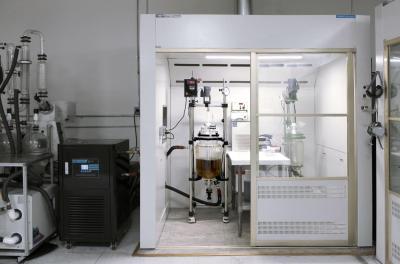
G6M says that the new reactor increases the company’s GO production capacity five-fold. The first batch of graphene oxide from the New Reactor was produced on November 26, 2021.
Graphene oxide could improve aircraft fuel
A team of researchers at UBC Okanagan (UBCO), studying the burning rate of nanomaterials in liquid fuels, believe they have created a recipe for clean-burning, power-boosting aircraft fuel.
 A droplet of fuel mixed with nanomaterials is ignited during an experiment in UBCO’s Combustion for Propulsion and Power Lab. Image credit: UBCO
A droplet of fuel mixed with nanomaterials is ignited during an experiment in UBCO’s Combustion for Propulsion and Power Lab. Image credit: UBCO
The team is investigating the combustion characteristics of microscopic graphene oxide inside fuel. Their experiment measures the ignition delay, burn rate and speed by which the graphene particles and fuel separate into smaller particles. Working with our industry partner, ZEN Graphene Solutions, we are assessing how the burn rate of this mixture can potentially improve its combustion properties, explains lead author and doctoral student Sepehr Mosadegh.
New GO–MnO2 nano-filter can efficiently clean water from toxic dyes
Researchers from Korea's University of Seoul, Russia's RUDN University and several India-based institutes have created a nano-filter for water purification from synthetic dyes. The graphene-based composite can reportedly remove up to 100% of harmful compounds from water, and it can be used up to seven times without losing efficiency. In addition, the synthesis of the nanofilter itself is economical and environmentally friendly.
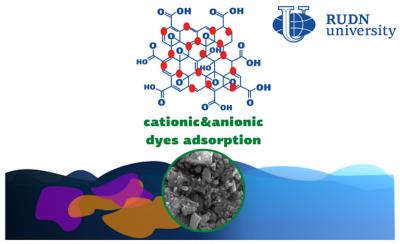
Synthetic dyes are used in industrial chemistry and pharmaceuticals. They reach the wastewater together with other industrial waste and pollute the environment. Existing methods of water purification are not quite practical, as the proposed adsorbents are usually disposable and work slowly. Therefore, scientists continue to look for effective and eco-friendly solutions to this problem. The team in this recent work has proposed a reusable graphene-based nanocomposite that can quickly absorb dyes from water.
Metalgrass offers a discounted yearly market reports package
Metalgrass (Graphene-Info) is now offering a new subscription service for enterprises that want access to our complete collection of market reports.

For $3,500 per year, you will get an Enterprise License to all of our market reports. Metalgrass currently offers 12 market reports, plus 4 handbook guides, and all of these are included in the subscription (bought separately, these will cost over $10,000!). You will also have access to all new reports, updates and guides released in the future (during the yearly subscription period).
Our Enterprise License gives access to your entire organization: you can share the report with all the company employees via mail, shared server or any other digital way.
Graphene-Info updates all its graphene market report
Today we published new versions of all our graphene market reports. Graphene-Info provides comprehensive niche graphene market reports, and our reports cover everything you need to know about these niche markets. The reports are now updated to October 2021.
The Graphene Batteries Market Report:
- The advantages using graphene batteries
- The different ways graphene can be used in batteries
- Various types of graphene materials
- What's on the market today
- Detailed specifications of some graphene-enhanced anode material
- Personal contact details into most graphene developers
The report package provides a good introduction to the graphene battery - present and future. It includes a list of all graphene companies involved with batteries and gives detailed specifications of some graphene-enhanced anode materials and contact details into most graphene developers. Read more here!
Novel graphene fiber electrode could assist in developing advanced therapies in bioelectronic medicine
An international team that included researchers from the ARC Centre of Excellence for Electromaterials Science (ACES) and the University of Houston has helped progress electroceutical research for treatment of diseases including rheumatoid arthritis, colitis and sepsis.
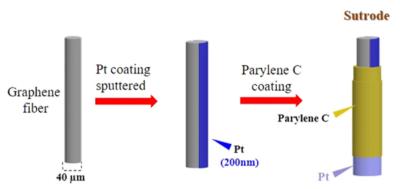 Coating steps of extruded Pt-rGO electrodes. Image from article
Coating steps of extruded Pt-rGO electrodes. Image from article
The team released their latest paper, that builds on previous studies where the team reported on the 'Sutrode' - a graphene based electrode created using the fabrication technique known as fiber wet spinning.
Pagination
- Previous page
- Page 5
- Next page


